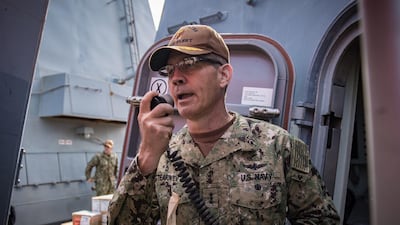The commander of US Naval Forces Central Command was found dead in his residence in Bahrain.
Chief of Naval Operations Admiral John Richardson said Vice Admiral Scott Stearney was found dead on Saturday. The US Navy in co-operation with Bahrain's Ministry of Interior are investigating the death, but have yet to reach a conclusion. However, no foul play is suspected, Adm Richardson said in a statement.
The top US naval commander had pledged to defend critical shipping routes through the Red Sea and Arabian Gulf from Iranian threats, who he described as having “malign interests” aimed at destabilising the region.
Stearney was also commander for the Fifth Fleet, which includes the Arabian Gulf, Gulf of Oman, Gulf of Aden, Red Sea and the Arabian Sea.
Rear Admiral Paul Schlise, the deputy commander of Fifth Fleet, has taken over Stearney's duties.
Adm Richardson described Stearney as a decorated naval warrior, a devoted husband and father, and a good friend.
Stearney oversaw the launching of new F-35 stealth fighters, which are conducting four naval exercises focused on three critical congestion points of the Suez Canal, Bab El Mandeb and the Straits of Hormuz.
The fleet's operations span over 4 million square kilometres of water area and is comprised region is comprised of 20 countries.
The Chicago native entered the US Navy in 1982 after graduating from the University of Notre Dame with a bachelor's degree in economics. He later obtained a master's degree from the National Defense University.
He served in several strike fighter squadrons flying the FA-18 Hornet and served in Kabul, Afghanistan, as Chief of Staff of Joint Task Force 435 and later Combined Joint Interagency Task Force 435.
In the US, Stearney served in various roles, including as instructor and readiness officer at Navy Fighter Weapons School, according to his official biography. He also held various senior posts, including director of operations at US Central Command.
_______________
Read more:
US navy pledges to keep shipping routes open in face of Iranian threats
US Centcom chief visits Yemen in warning to Iran
Beyond the Headlines podcast: Why the Strait of Hormuz is so important
_______________
The efforts of Fifth Fleet are critical to "maintaining communication, deterring disruptive adversaries, and strengthening regional partner maritime capabilities to promote a secure maritime environment", according to their website.
Through them, the Pentagon has kept tabs on Iran's activity in the Arabian Gulf, the Strait of Hormuz and Gulf of Oman.
They have recently been responsible for confronting Houthi rebels in Yemen who have fired missiles at oil tankers in the Red Sea and the Iranian navy, which has recently been forced to curtail harassment of US navy vessels.
In total, the Fifth Fleet is responsible in overseeing security in over 20 nations in the region.
The fleet consists of several task forces, including Task Force 56, which includes inshore boat units, mobile construction battalions and even marine mammals, including bottle-nose dolphins and California sea lions, both of which can be trained to detect and locate objects in the ocean.

